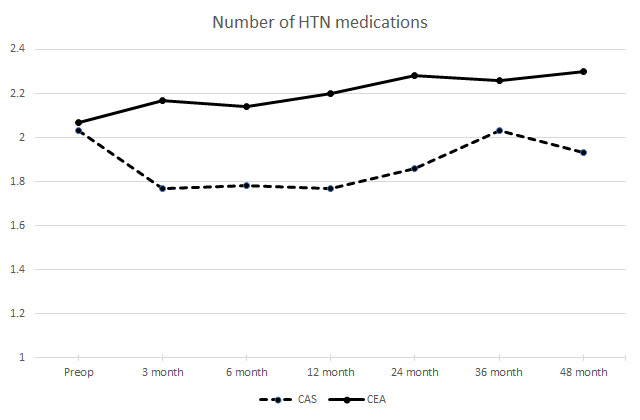Long term Hemodynamic Effects after Carotid Artery Intervention
SUNGHO LIM, MD, Michael J. Javorski, MS, Yaeji Park, Sean P. Nassoiy, DO, Pegge M. Halandras, MD, Bernadette Aulivola, MD, Paul Crisostomo, MD.
LOYOLA UNIVERSITY, MAYWOOD, IL, USA.
OBJECTIVES: The baroreceptor at the carotid body plays a key role for hemodynamic autoregulation. Manipulation of the baroreceptor during carotid endarterectomy (CEA) or radial force from carotid artery angioplasty and/or stenting (CAS) may cause both intraoperative as well as postoperative hemodynamic instability. The purpose of this study is to evaluate longer term effects of CEA and CAS on blood pressure and heart rate and subsequent changes on antihypertensive medications.
METHODS: A retrospective chart review was performed to identify patients who underwent CEA or CAS between 2009 and 2015 at a single tertiary care institution. Baseline demographics and comorbidities were recorded. Degree of bilateral carotid artery stenosis and detailed intraoperative techniques were reviewed. Hemodynamic parameters such as blood pressure (BP), heart rate (HR) and anti-hypertensive medication requirement were evaluated at 3, 6, 12, 24, 36 and 48 month
RESULTS: A total of 289 patients were identified. The average age was 78.7 years, and males constituted 64.0%. All patients had moderate (>50%) to severe (>80%) carotid stenosis. Post-operative mortality and stroke free survival were comparable between CAS and CEA cohorts. Systolic BP of CAS and CEA were similar over the follow up period. HR remained stable postoperatively. A decreased number of anti-hypertensive medications (∆N) was observed in the CAS cohort for the first 2 years compared to the CEA cohort: -0.23 vs +0.11 (p<0.01) at 3 month, -0.20 vs +0.09 (p<0.01) at 6 month, -0.23 vs +0.14 (p<0.01) at 1 year, -0.23 vs +0.30 (p<0.01) at 2 year, -0.11 vs +0.20 at 3 year (p=0.12), -0.04 vs +0.27 at 4 year (p=0.16), respectively.
CONCLUSIONS: Surgical intervention for carotid stenosis poses a risk of postoperative hemodynamic dysregulation. Postoperative blood pressure and heart rate remained relatively stable after both CAS and CEA. The number of anti-hypertensive medications was decreased after CAS for 2 years postoperatively. Vascular surgeons should closely monitor blood pressure and consider modulating anti-hypertensive medication following CAS. 
Back to 2018 ePosters




